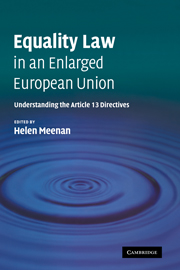Book contents
- Frontmatter
- Contents
- Preface
- Acknowledgements
- List of contributors
- Abbreviations
- Table of Cases
- PART I
- PART II
- 5 EU sex equality law post-Amsterdam
- 6 EU anti-racism policy; the leader of the pack?
- 7 Religion or belief; aiming at the right target?
- 8 Disability discrimination law in the European Union
- 9 Age discrimination – Of Cinderella and The Golden Bough
- 10 The ‘mainstreaming’ of sexual orientation into European equality law
- 11 Conclusion
- Index
9 - Age discrimination – Of Cinderella and The Golden Bough
Published online by Cambridge University Press: 22 August 2009
- Frontmatter
- Contents
- Preface
- Acknowledgements
- List of contributors
- Abbreviations
- Table of Cases
- PART I
- PART II
- 5 EU sex equality law post-Amsterdam
- 6 EU anti-racism policy; the leader of the pack?
- 7 Religion or belief; aiming at the right target?
- 8 Disability discrimination law in the European Union
- 9 Age discrimination – Of Cinderella and The Golden Bough
- 10 The ‘mainstreaming’ of sexual orientation into European equality law
- 11 Conclusion
- Index
Summary
One of the powerful themes in this chapter is the role physical appearance plays in age discrimination. This is vaguely reminiscent of ancient kings being executed at the first sign of physical defect. The purpose of regicide was to avert decay in the country and was best carried out when the king was still healthy. While these customs have disappeared, many otherwise erudite thinkers see age as different from other grounds and age discrimination as more acceptable than other forms. This acceptance is sometimes based on stereotypes of people of a certain age or on the traditional use of age as a rational management and organisational tool. Confusion has even surrounded what age discrimination actually is. This chapter has two deceptively simple aims: first, to explore age as a human characteristic and how it can impact on work and life; and second, to examine the age strand within the Employment Equality Directive (Employment Directive) and wider contexts. It will emerge that although age differs in some respects from the other Article 13 EC Treaty grounds, just as they all differ from each other, age discrimination is not necessarily different and may particularly hurt those at the intersection of age and other grounds. The inclusion of age in the Employment Directive has already achieved two important results. Firstly, age discrimination is prohibited in each Member State, nominally providing a uniform minimum level of protection, and secondly, there now exists a definition of age discrimination in European law.
- Type
- Chapter
- Information
- Equality Law in an Enlarged European UnionUnderstanding the Article 13 Directives, pp. 278 - 312Publisher: Cambridge University PressPrint publication year: 2007



